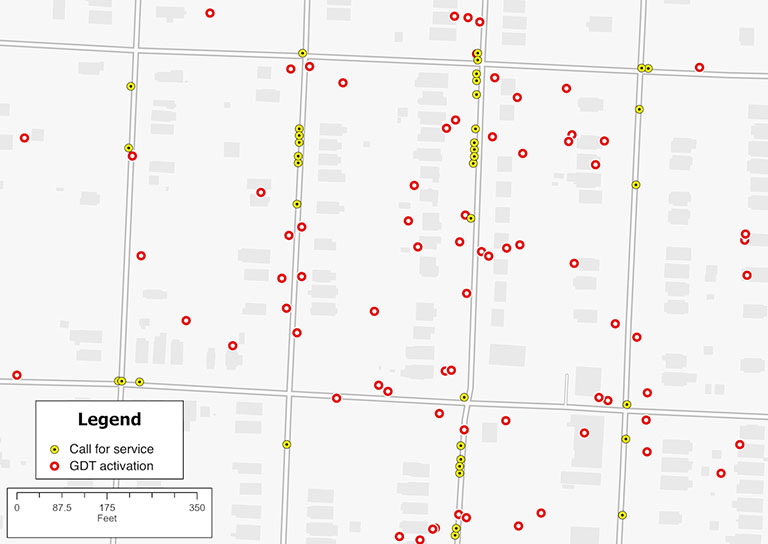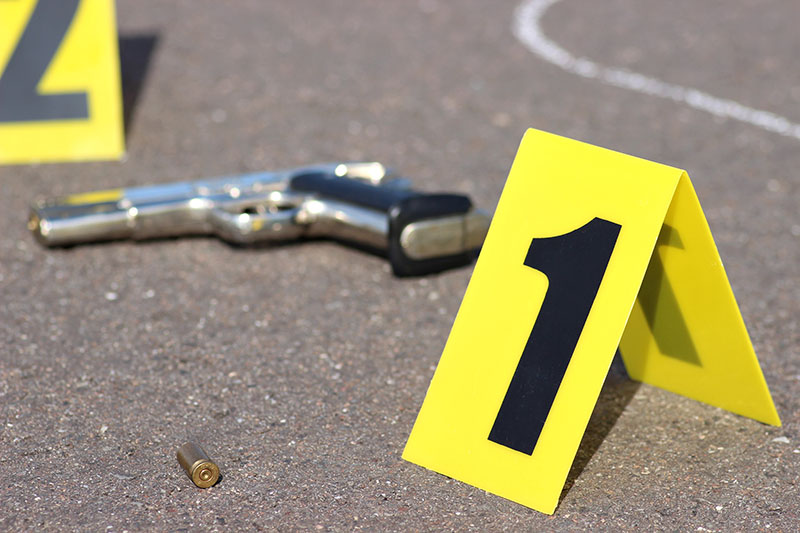Research shows that in most cities, fewer than 5% of city blocks account for about 50% of all crime. This means a small number of residents are at the highest risk of becoming the victim of crime, even when overall rates decline.
Like many large cities in the US, Detroit’s gun violence rate has fluctuated since the Covid-19 pandemic and the unrest after the murder of George Floyd in 2020.
The city’s murder rate increased nearly 20% that year, meaning the city had the second-highest violent crime rate after Memphis, Tennessee, among cities with more than 100,000 residents.
However, by the end of 2023, non-fatal shootings dropped nearly 16% from the prior year and homicides returned to pre-pandemic levels, with this reduction continuing so far in 2024.
Focusing on city-wide crime rates, however, can hide significant local variations. Research shows that in most cities, fewer than 5% of city blocks account for about 50% of all crime. This means a small number of residents are at the highest risk of becoming the victim of crime, even when overall rates decline.
High-profile incidents, like the recent mass shooting that killed two and injured 19 at a Detroit block party in the city’s Mohican Regent neighborhood, highlight that gun violence remains a significant threat to these vulnerable communities.
Gunshot detection technology
More than 170 cities and towns across the US have adopted ShotSpotter, with costs ranging from US$65,000 to $90,000 per square mile per year, and a one-time initiation fee of $10,000 per square mile.
One method Detroit and other cities facing high levels of gun violence have employed is gunshot detection technology, specifically the industry-leading ShotSpotter product, which uses acoustic sensors to notify police when the system hears gunfire.
Since 2020, my colleagues and I have conducted the largest study on this technology, funded by a grant from the National Institute of Justice. Our study used over 15 years of data from Chicago and Kansas City, comparing ShotSpotter target areas with similar control areas not covered.
Our findings were published in a technical report to NIJ and in five peer-reviewed journal articles as of July 2024. Our research has important implications for public safety, given the popularity of ShotSpotter.
More than 170 cities and towns across the US have adopted ShotSpotter – the industry-leading gunshot detection technology system manufactured by SoundThinking – with costs ranging from US$65,000 to $90,000 per square mile per year, and a one-time initiation fee of $10,000 per square mile. Detroit’s $7 million contract covers 40 square miles.
ShotSpotter alert and 911 call locations

This map shows the locations of ShotSpotter alerts and 911 calls reporting sounds of shots fired in Kansas City, Mo. Created by Eric L. Piza.
However, ShotSpotter is controversial. Critics argue that it is unreliable, does not meaningfully improve public safety and leads to over-policing. Criticism has led to cities like Chicago cancelling their contracts. Others, such as Portland, Oregon, decided not to pursue the technology in favor of alternative strategies. Debates about ShotSpotter are ongoing in other cities like Boston and New York.
In Detroit, the police department defended its use of the acoustic sensors, proclaiming “ShotSpotter continues to be a valuable tool in helping the Detroit Police Department respond to and investigate shots fired incidents in the city, by quickly sending officers to the locations” in a July 2023 statement to Bridge Detroit.
Activists say the funds would be better spent on non-police methods to improve public safety.
A prominent example of non-police methods activists advocate for is the similarly named ShotStoppers program, funded with $10 million from the American Rescue Plan Act, which involves violence interrupters, or trained community members, who attempt to talk potential shooters out of committing violence.
Critics argue that community-based programs like these are less likely to cause harm than ShotSpotter, which they argue is discriminatory given its deployment in predominately low-income communities of color.
Our research was designed to test both the efficiency and effectiveness of this technology. Here are our five key takeaways.
1: Faster responses to gunfire
Using GPS trackers, we found that officers in both Chicago and Kansas City stopped their patrol vehicles closer to the location of reported gunfire when responding to ShotSpotter alerts than 911 calls.
In Kansas City, we found that ShotSpotter alerts went off 93 seconds before the first 911 call reporting the same incident on average.
This 93-second time savings shaved off nearly 12% of the overall police response, EMS response and hospital transport travel times. This means that ShotSpotter can offer an important head start and get victims to the hospital faster.
Our analysis further found that ShotSpotter may provide more precise incident locations. In more than 26% of cases, ShotSpotter alerts and 911 calls were reported as occurring greater than one block apart.
Using GPS trackers, we found that officers in both Chicago and Kansas City stopped their patrol vehicles closer to the location of reported gunfire when responding to ShotSpotter alerts than 911 calls.
2: No increase in enforcement compared with 911 calls
Critics argue that ShotSpotter targets low-income communities of color, while supporters claim that coverage areas reflect gun violence levels. The data from Chicago lent credence to both perspectives.
In that city, the ShotSpotter target area had about twice the non-white population and a poverty rate about 50% higher than the remainder of the city. Gun crime rates were as much as 1.5 times higher in the ShotSpotter target area.
An important question is whether ShotSpotter more often led to police enforcement, specifically against people of color. We found both ShotSpotter and citizen calls to 911 prompt arrests and stops of citizens at similar levels.
Interestingly, the relative effect of ShotSpotter and 911 calls was consistent across different racial groups in most instances, indicating that ShotSpotter does not generate additional racial disparities in enforcement beyond those already present in standard police responses to gunfire.
3: Not all calls can be confirmed
In both Chicago and Kansas City, ShotSpotter did not increase the clearance rates – or proportion of cases solved by police – for either fatal shootings or non-fatal shootings.
A prime selling point for ShotSpotter is the system’s ability to correctly identify gunshots, giving police a better opportunity to respond to the scene, collect evidence and apprehend shooters. But how accurate is it?
In Kansas City, we found that shots-fired incidents occurring in the ShotSpotter target area were 15% more likely than 911 calls to be classified as “unfounded,” meaning evidence of gunfire couldn’t be confirmed.
We did not have the necessary data to determine why this is the case. Police can fail to find evidence of shots fired for several reasons unrelated to ShotSpotter – for example, revolvers do not leave any shells behind, and gun assault victims who are unhurt may choose not to cooperate with police.
However, false positive ShotSpotter alerts are one viable explanation.
4: No increase in clearance rates
In Kansas City, the collection of ballistic evidence and recovery of firearms was substantially higher in the ShotSpotter target area than the controls. While we did not have ballistic evidence data in Chicago, we found that ShotSpotter similarly led to a significant increase in firearm recoveries.
However, our results indicate that these evidence collection improvements did not lead to more effective investigations. In both Chicago and Kansas City, ShotSpotter did not increase the clearance rates – or proportion of cases solved by police – for either fatal shootings or non-fatal shootings.
5: No reduction in gunshot victimization
In both Chicago and Kansas City, ShotSpotter did not reduce the occurrence of fatal shootings, non-fatal shootings or other violent felonies committed with firearms.
After Kansas City implemented ShotSpotter, 911 calls for sounds of shots fired decreased; however, the number of gun violence victims did not. In Chicago, there was no change in the number of 911 calls.
This article first appeared on The Conversation, and is republished under a Creative Commons licence; you can read the original here.
About the Author
 Dr Eric L. Piza is Professor of Criminology and Criminal Justice, Director of Crime Analysis Initiatives, and Co-Director of the Crime Prevention Lab in the College of Social Sciences and Humanities at Boston’s Northeastern University. His research focuses on the spatial analysis of crime patterns, evidence-based policing, crime control technology, and the integration of academic research and police practice. Dr Piza has received over $3.9 million in outside research grants, including awards from the National Institute of Justice, Bureau of Justice Assistance, US Department of State, Swedish National Council on Crime Prevention, and the Charles Koch Foundation’s Policing & Criminal Justice reform program.
Dr Eric L. Piza is Professor of Criminology and Criminal Justice, Director of Crime Analysis Initiatives, and Co-Director of the Crime Prevention Lab in the College of Social Sciences and Humanities at Boston’s Northeastern University. His research focuses on the spatial analysis of crime patterns, evidence-based policing, crime control technology, and the integration of academic research and police practice. Dr Piza has received over $3.9 million in outside research grants, including awards from the National Institute of Justice, Bureau of Justice Assistance, US Department of State, Swedish National Council on Crime Prevention, and the Charles Koch Foundation’s Policing & Criminal Justice reform program.
Picture © Bjoern Wylezich / Shutterstock



We tried this system in Trinidad and Tobago in the early noughties when I was part of a UK Policing Team investigating shooting incidents and homicides on the island. Our HQ was a tower block based in one of the gang areas so they decided to install shot spotter on the roof of the building as it appeared to give an all around horizon view of the area. It worked well save for one small oversight. We had a better indication of where the guns were from the direction of the holes in the mast from rounds fired at the mast whilst the engineers were installing it than when the system was operational. It was discontinued shortly after!!